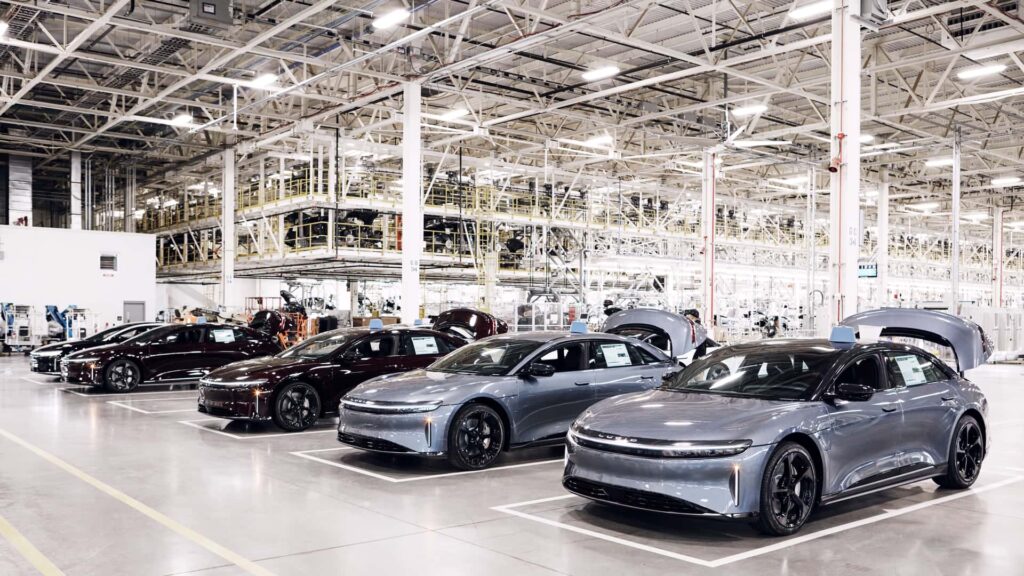Lucid makes what is ostensibly the most efficient luxury electric sedan on the market, the Air. But according to head honcho Peter Rawlinson, EVs need to become even more efficient to “save the planet.” He noted in an interview with the UK’s Autocar that “the holy grail” would be an electric car capable of driving 6.2 miles (10 km) on one kilowatt-hour of energy calculated according to the stringent US EPA guidelines for EVs.
That’s about 1.5 times more efficient than the most frugal version of the Lucid Air, the entry-level Air Pure RWD. The Pure RWD’s EPA-rated 4.1 miles/kWh puts it considerably ahead of the most efficient version of the Tesla Model S. It’s only beaten by the Hyundai Ioniq 6.
Get Fully Charged
EV efficiency is key
Many EV advocates believe that efficiency—the ability to turn energy into motion without waste—is an even more important metric than just driving range. Startup Lucid is a leader in EV efficiency and doesn’t believe bigger batteries alone are the key to maximizing range.
It should be noted that Lucid rates the driving efficiency of the Air Pure, with 19-inch wheels, differently (and higher) than the EPA does at 4.76 mi/kWh. A Lucid spokesperson told InsideEVs that their calculation deals more with how much energy from the battery the car will need to travel a certain distance, and not how much energy you’ll need if you are fully recharging a nearly dead battery with a home charger. “Or to put it another way, 4.7 mi/kwh is battery-to-wheel, in contrast with the EPA numbers which measure wall-to-wheel,” the spokesperson told us.
As a result, Rawlinson told Autocar that the company thinks the Air can be pushed to 5 miles/kWh “pretty soon,” although he didn’t say when or how Lucid was going to achieve this significant efficiency gain.
The Lucid boss held a talk during the Car of the Year event held at this year’s Geneva Motor Show. “People think that we’re on a bandwagon of making expensive, luxury SUVs but we’re here to advance the technology with state-of-the-art EVs,” he said, per Autocar.
This is a reiteration of what he’s said many times in various contexts, promoting a company philosophy that transcends the brand and portrays Lucid as a real force that is working towards the advancement and proliferation of EVs—a bit like Tesla, but with a different flavor.

Unlike most electric vehicle manufacturers (excluding Tesla), which source key parts from third-party suppliers, Lucid has designed most of its components in-house to work with its novel 900-volt EV architecture.
Having such a high voltage has allowed Lucid to reduce the size of many key components, and it also helps with the efficiency of its vehicles. We were hugely impressed when, in 2022, our own Tom Moloughney exceeded 500 miles in a Lucid Air Dream Edition while driving at a constant 70 mph on the highway, probably one of the most significant range tests we’ve ever done.
The Air could average 4.3 miles/kWh in that test because each of its major components was designed to work together with the utmost efficiency in mind, and it remains unbeaten to this day.
Rawlinson didn’t say when, but he noted that “not far in the future, you can get 10km per kWh and then it’s a 300km range from a 30 kWh battery, which is much smaller than today. Then you can reduce the cost of the battery from $20,000 to around $3000-$4000 with proper industrialization and economies of scale.”

Lucid is also working on a more affordable EV to rival Tesla’s smaller offerings, the Model 3 and Model Y. Rawlinson told us in late 2023 that this $50,000 model would debut around the middle of the decade, but he didn’t mention how efficient it would be. We can speculate that being a smaller vehicle benefiting from EV tech that has advanced a few years since the introduction of the Air, this cheaper Lucid will be one of the most efficient EVs on the market.
Granted, Lucid faces an uncertain future, like many EV startups. The company required a substantial cash injection last year from its majority shareholder, the Private Investment Fund of Saudi Arabia. But it hopes that the rollout of the Gravity SUV, and ultimately the smaller and more affordable EV, will help it cross the “valley of death” and reach the scale it needs to be stable long-term. The company recently expanded its Arizona factory for exactly that effort.
Whether this plan will achieve Rawlinson’s holy grail remains to be seen, but it’s certainly something exciting for EV enthusiasts to look forward to.

